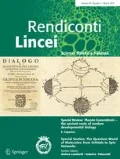Abstract
From November of 1991 through August of 1994 two sediment traps were deployed on the vertical array in Bannock Basin, one being above the seawater brine interface (2900 m) and one below (3450m). The purpose of this paper is to present the first 6-month biogenic flux data. The dominant biogenic group, in both the Bannock Basin sediment traps, is constituted by coccoliths. During the 6-month study the maximum calculated coccolith fluxes ranged from 3 X 108 coccoliths/m2 / day in early April 1992 in the sediment trap located in anoxic conditions and 4 X 107 coccoliths/m2 / day in early May 1992 in the shallower sediment trap. The biogenic siliceous material consists of diatoms, silicoflagellates, siliceous frustules and, secondarily, radiolaria. The total biogenic fluxes are always higher in the trap positioned in the brine and are associated with high abundances ofDiscoaster spp. Most of theDiscoaster spp. are probably reworked by sliding from the steep side walls of the basin and resuspended in the brine. During the studied period the biogenic flux pattern is characterized by a general increase from November to May. For the upper sediment trap this could be the result of an increase of late winter-spring primary productivity.
Riassunto
Due trappole per sedimenti sono state messe in opera, in verticale, dal Novembre 1991 all’Agosto 1994 nel Bacino Bannock, una sopra l’interfaccia acque marine normali/salamoie anossiche a 2900 m e l’altra sotto, a 3450 m di profondità. Lo scopo di questo articolo è quello di presentare i risultati dei primi sei mesi di raccolta. Il gruppo biogenico dominante in entrambe le trappole per sedimenti è costituito dai coccoliti. I massimi flussi di coccoliti calcolati nei primi sei mesi di raccolta variano da 3 x 108 coccoliti/m2/giorno, all’inizio di Aprile 1992 in condizioni anossiche a 4 x 107 coccoliti/m2/giorno, all’inizio di Maggio 1992 nella trappola per sedimenti più superficiale. Le diatomee, le silicoflagellate e secondariamente i radiolari costituiscono il materiale biogenico siliceo. I flussi biogenici totali sono sempre più alti nella trappola per sedimenti ubicata in ambiente anossico e sono associati ad alti valori di flussi diDiscoaster spp. Questi ultimi sono probabilmente rimaneggiati per lo scivolamento dai ripidi fianchi del bacino e risospesi nelle salamoie. Durante il primo periodo di studio l’andamento dei flussi biogenici è caratterizzato da un generale aumento dal Novembre 1991 al Maggio 1992. Per la trappola per sedimenti più superficiale questo potrebbe essere il risultato di un aumento della produttività verificatosi a fine inverno-inizio primavera.
Similar content being viewed by others
References
Camerlenghi A., 1988. Subsurface Dissolution of Evaporites in the Eastern Mediterranean Sea. MS Thesis,
Texas A&M University, College Station. Camerlenghi A., 1989. Submarine dissolution of evaporites in the Eastern Mediterranean Sea. In: M. B. Cita, A. Camerlenghi , Corselli (eds.), Anoxic Basins of the Eastern Mediterranean. Ric. Sci., suppl. 72: 12-14.
Camerlenghi A., Cita M. B., 1987.Setting and tectonic evolution of some Eastern Mediterranean deep-sea basins. Mar. Geol., 75: 31–56.
Camerlenghi A., McCoy W. F., 1990.Physiography and structure of Bacino Bannock (Eastern Mediterranean). Geomar. Lett., 10(1): 15–23.
Castradori D., 1993. Nannofossili calcarei come strumento per lo studio biostratigrafico e paleoceanografico del Quaternario nel Mediterraneo orientale. Università di Milano, PhD Dissertation.
Cita M. Aghib F., Cambi A., Camerlenghi A., Corselli C., Erba E., Giambastiani M., Herbert T., Kastens K. Leoni C., Malinverno P., McCoy F., Nosetto A., Parisi E., Spezzibottani G., 1986a.Precipitazione attuale di gesso in un bacino anossico profondo: prime osservazioni geologiche, idrologiche, paleontologiche sul Bacino Bannock (Mediterraneo Orientale). G. Geol., 47 (1–2): 143–163.
Cita M.B., Fornaciari M., Camerlenghi A., Corselli C., Erba E., McCoy F. W., Vezzoli L., 1986b.Anoxic basins of the Eastern Mediterranean: New evidence from the Bacino Bannock area. Mem. Soc. Geol. It., 36: 131–144.
De Lange G. J., Middelburg J. J., Van Der Weijden C. H., Catalano G., Luther G. W. Hydes D. J., Woittiez J. R. W., Klinkhammer G. P., 1990.Composition of anoxic hypersaline brines in the Tyro and Bannock Basins, Eastern Mediterranean. Marine Chem., 31: 63–88.
Dugdale R. C., Wilkerson F. P., 1988.Nutrient sources and primary production in the Eastern Mediterranean. Ocean. Acta, no spec. 9: 170–184.
Estrada M., Vives F., Alcarez M., 1985.Life and productivity of the open ocean. In: R. Margalef (ed.),Key Environments: The Western Mediterranean. Pergamon, New York: 148–197.
Honjo S., Roman M. R., 1978.Manne copepod fecal pellets: production, preservation and sedimentation. J. Mar. Res., 36: 45–57.
Honjo S., Manganini S. J., Poppe A., 1982.Sedimentation of lithogenic particles in the deep ocean. Mar. Geol., 50: 199–220.
Krom M. D., Brenner S., Kress N., Gordon L. I., 1992.Nutrient dynamics and new production in a warmcore eddy from the Eastern Mediterranean Sea. Deep-Sea Res., v. 39, n. 3/4: 467–480.
Makgalef R., 1985.Introduction to the Mediterranean. In: R. Makgalef (ed.),Key Environments: The Western Mediterranean. Pergamon, New York: 1–16.
Montagnana S., Sala M. 1993.La sedimentazione nell’ambiente anossico del Bacino Bannock (Mediterraneo orientale): caratterizzazione chimica, fisica e biologica dei sedimenti. Rend. Fis. c. Lincei, s. 9, v. 4: 213–236.
Parisi E., Erba E., Cita M. 1987.Stratigraphy and sedimentation in the anoxic Bannock Basin (Eastern Mediterranean). Mar. Geol., 75: 93–117.
Author information
Authors and Affiliations
Additional information
Nella seduta del 3 novembre 1994.
Rights and permissions
About this article
Cite this article
Ziveri, P., Grandi, C., Stefanetti, A. et al. Biogenic fluxes in Bannock Basin: first results from a sediment trap study (November 1991 - May 1992). Rend. Fis. Acc. Lincei 6, 131–145 (1995). https://doi.org/10.1007/BF03001662
Issue Date:
DOI: https://doi.org/10.1007/BF03001662




